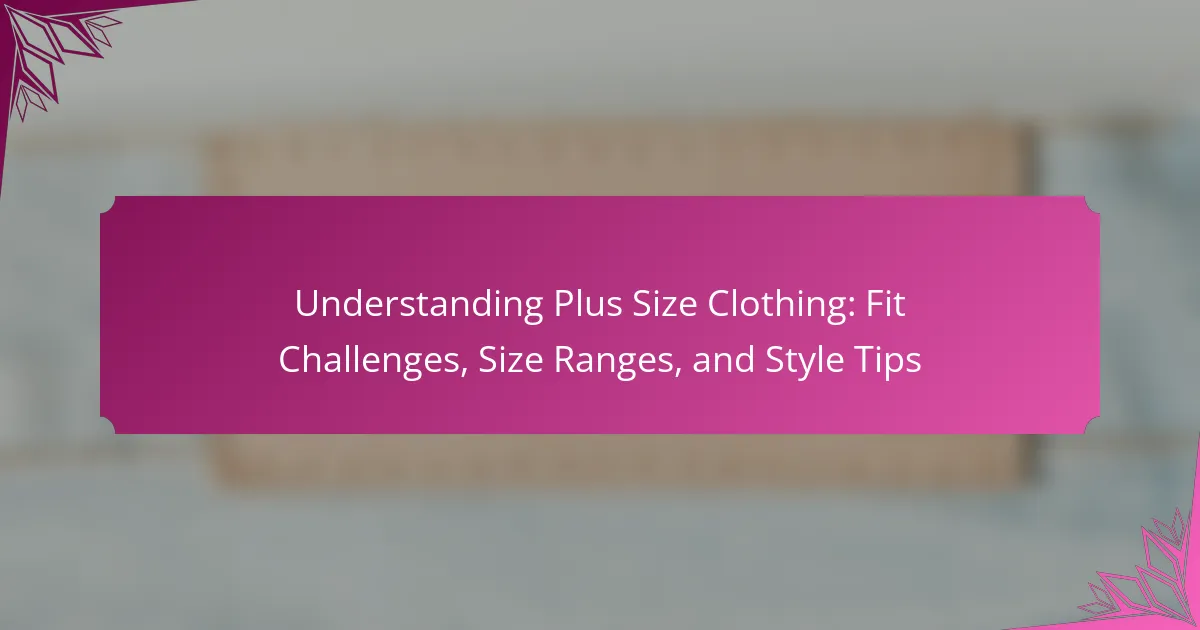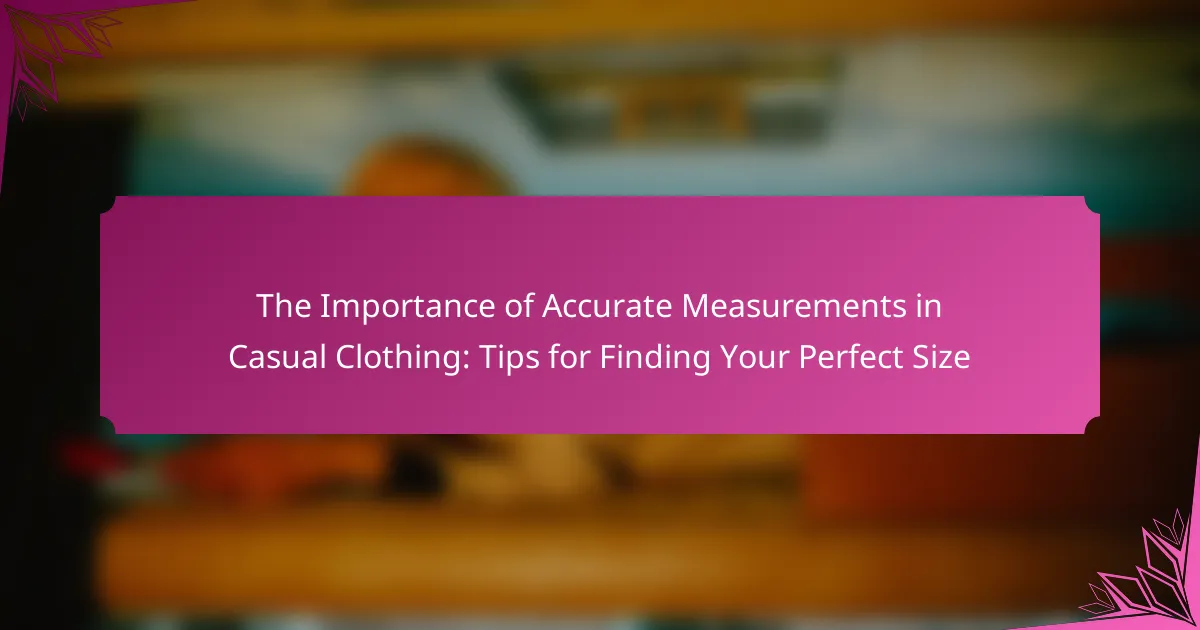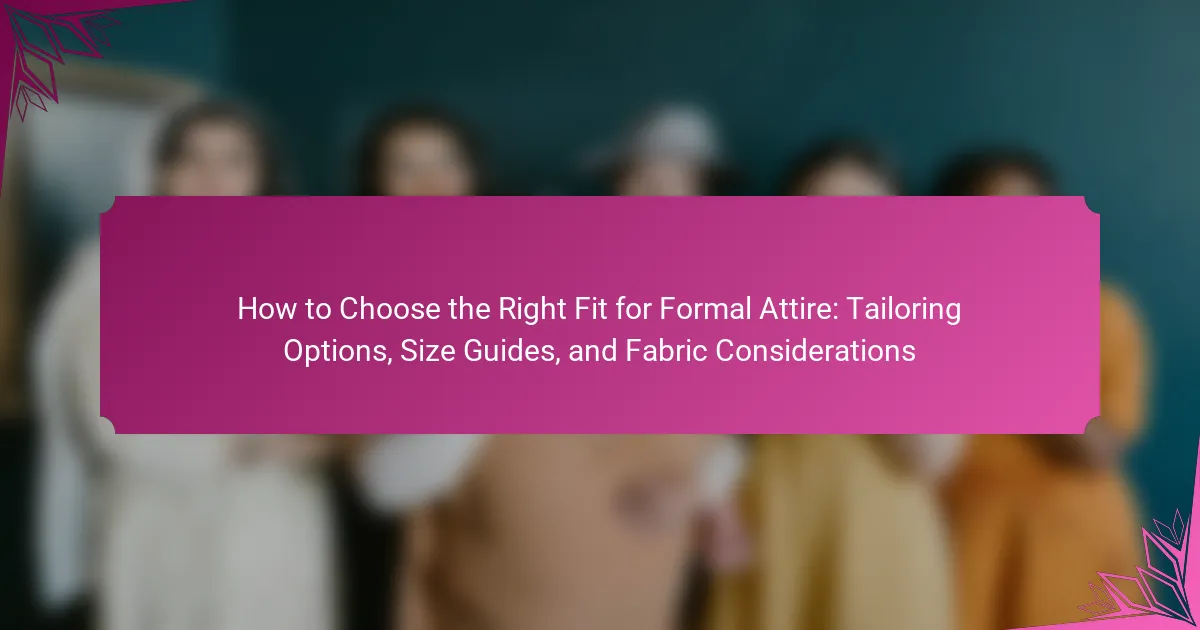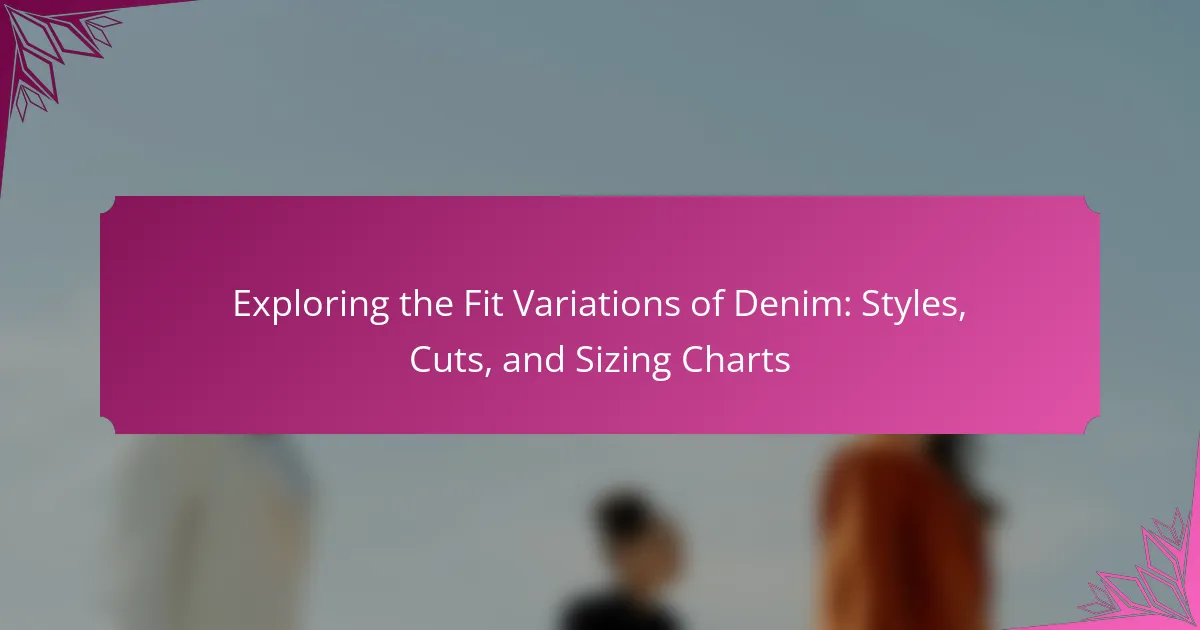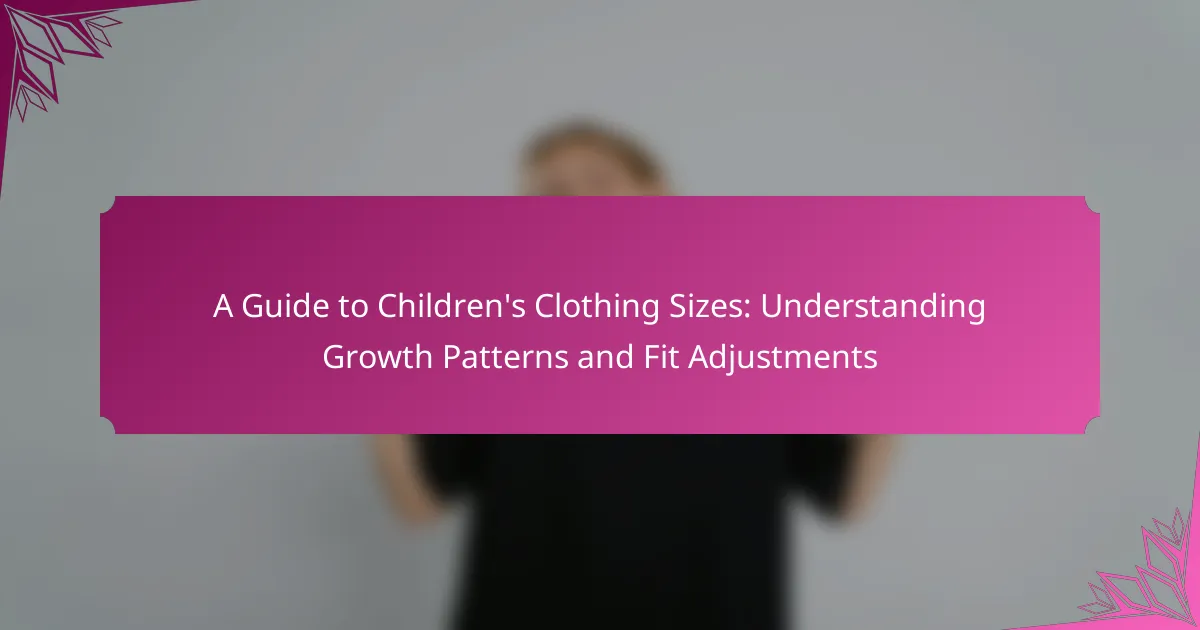Plus size clothing encompasses garments designed for individuals typically above a size 14 in women’s fashion, addressing the unique fit and style needs of larger body types. This category includes a wide range of styles such as casual, formal, and activewear, aiming to provide comfort and enhance body confidence. The article explores the size classifications within plus size clothing, which generally range from size 14 to size 32, and highlights the growing demand for inclusive sizing in the fashion industry. Additionally, it offers practical style tips for selecting well-fitted clothing that flatters various body shapes, emphasizing the importance of tailored garments, color choices, and quality fabrics.
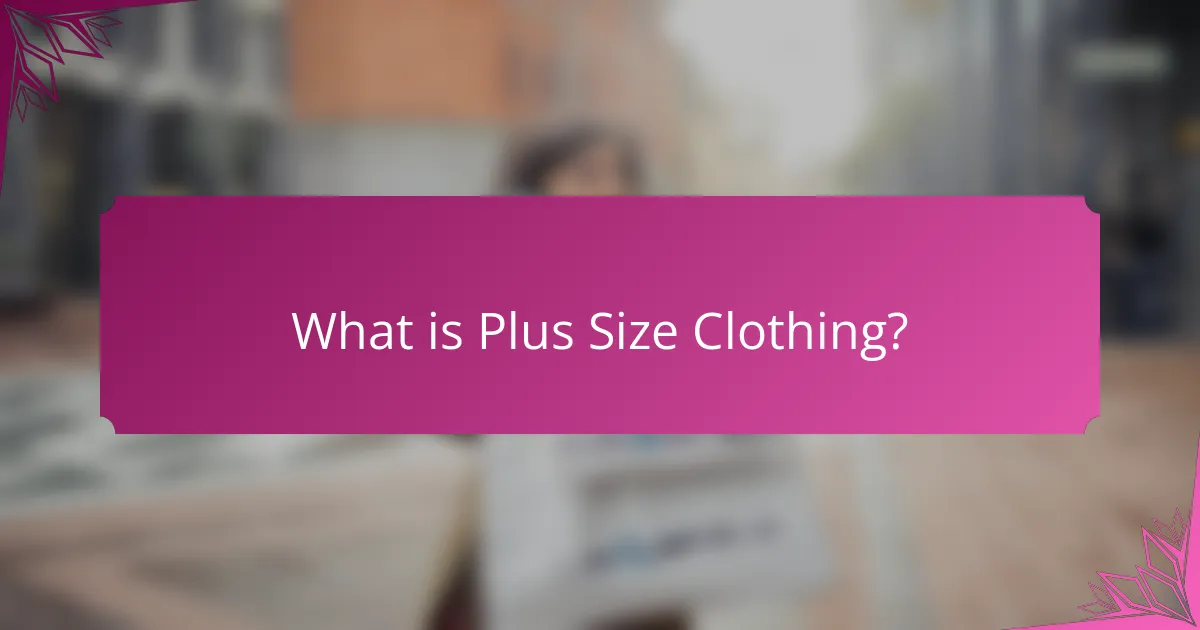
What is Plus Size Clothing?
Plus size clothing refers to garments designed for individuals typically above a size 14 in women’s fashion. This category addresses the specific fit and style needs of larger body types. Plus size clothing incorporates a variety of styles, including casual, formal, and activewear. It aims to provide comfort while enhancing body confidence. The term “plus size” is widely recognized in the fashion industry and is associated with inclusive sizing. Studies show that the demand for plus size clothing has increased significantly, reflecting changing body image perceptions. According to a report by the NPD Group, plus size women’s apparel sales reached $21 billion in 2020. This growth indicates a growing market for diverse body shapes and sizes.
How is Plus Size Clothing defined in the fashion industry?
Plus size clothing in the fashion industry is defined as apparel designed for individuals who wear larger sizes than the standard size range. Typically, this range starts at size 14 in women’s clothing and size 1X in plus size categories. Plus size garments are tailored to accommodate curvier body shapes, providing a better fit and comfort. The fashion industry recognizes plus size clothing as a distinct category to promote inclusivity and diversity in fashion. This recognition has led to a significant increase in brands offering stylish options for plus size consumers. According to a study by the NPD Group, the plus size market has grown substantially, reflecting changing consumer demands for representation.
What size ranges are typically considered plus size?
Plus size typically refers to clothing sizes 14 and above. In the U.S., this generally corresponds to a bust measurement of 40 inches or more and a waist measurement of 34 inches or more. Retailers may vary in their definitions, with some starting plus sizes at 12. The average American woman wears a size 16, which falls within the plus size range. This classification aims to provide options for individuals who do not fit standard sizing.
How do different brands define plus size categories?
Different brands define plus size categories based on varying size charts and measurements. Generally, plus size clothing starts at size 14 or 16 in the U.S. However, some brands may consider size 12 as plus size. Each brand has its own criteria for what constitutes plus size. For example, Lane Bryant typically starts at size 14, while ASOS defines plus size from size 14 and up. Additionally, some brands may use specific measurements for bust, waist, and hips to categorize sizes. This can lead to inconsistencies across different retailers. The inconsistency often causes confusion for consumers seeking the right fit.
What are the common fit challenges associated with Plus Size Clothing?
Common fit challenges associated with plus size clothing include inconsistent sizing, limited style options, and poor tailoring. Inconsistent sizing occurs because different brands use varied size charts. This can lead to confusion and frustration for consumers. Limited style options often result from a lack of variety in designs tailored for plus sizes. Many retailers may not offer trendy or fashionable choices. Poor tailoring can cause garments to fit awkwardly, leading to discomfort. For example, clothing may be tight in some areas while loose in others. These challenges can significantly impact the shopping experience for plus size individuals.
How do body shapes affect the fit of plus size garments?
Body shapes significantly affect the fit of plus size garments. Different body shapes, such as apple, pear, hourglass, and rectangle, require distinct design considerations. For example, apple-shaped individuals may need more room in the midsection. Pear-shaped bodies often require a fit that accommodates wider hips and thighs. Hourglass figures benefit from tailored garments that emphasize curves. Rectangle shapes may look for styles that create the illusion of curves. The right fit enhances comfort and confidence. Poorly fitting garments can lead to discomfort and dissatisfaction. Understanding body shapes is essential for creating flattering plus size clothing.
What are the most frequent fit issues encountered by plus size individuals?
Plus size individuals frequently encounter fit issues such as inadequate sizing options, poor garment proportions, and lack of support. Inadequate sizing options often result in limited availability of fashionable clothing. Poor garment proportions can lead to items that do not fit well in the bust, waist, or hips. Lack of support in garments, especially in areas like bras and swimwear, can affect comfort and confidence. Additionally, many plus size clothing items may not account for body shape variations, leading to further fit challenges. These fit issues are commonly reported in surveys and studies addressing plus size fashion.
Why is understanding fabric and construction important for Plus Size Clothing?
Understanding fabric and construction is crucial for plus size clothing because it directly impacts fit, comfort, and appearance. The right fabric allows for better draping and stretch, accommodating body shapes effectively. Construction techniques, such as seaming and tailoring, enhance the garment’s overall structure. For instance, fabrics with spandex provide flexibility, while breathable materials ensure comfort. Proper construction can also prevent common issues like gaping or pulling. Studies show that well-constructed plus size garments improve wearability and confidence. Therefore, knowledge of these elements aids in creating flattering and functional clothing options.
What types of fabrics work best for plus size clothing?
Natural fabrics like cotton and linen work best for plus size clothing. These materials provide breathability and comfort. Stretch fabrics such as spandex and elastane are also beneficial. They allow for better movement and fit. Blends of cotton with polyester can enhance durability. Fabrics with a slight stretch can help in creating a flattering silhouette. Additionally, jersey knit is often favored for its softness and drape. These fabric choices support both style and comfort for plus size wearers.
How does garment construction impact fit and comfort?
Garment construction significantly affects fit and comfort. The way a garment is designed and sewn influences how it conforms to the body. Key construction elements include seam placement, fabric choice, and pattern design. For instance, strategic seam placement can enhance mobility and reduce friction. Additionally, flexible fabrics can provide ease of movement, contributing to overall comfort. Research indicates that poorly constructed garments can lead to discomfort and restrict movement. A study by the Journal of Fashion Technology found that well-constructed clothing improves wearability and satisfaction. Therefore, thoughtful garment construction is essential for achieving optimal fit and comfort.
How can one choose the right style in Plus Size Clothing?
To choose the right style in plus size clothing, consider your body shape and personal preferences. Identify whether you are pear-shaped, apple-shaped, hourglass, or rectangular. Each shape has styles that enhance features and create balance. Opt for clothing that fits well without being too tight or too loose. Fabrics with a bit of stretch can provide comfort and a flattering silhouette. Choose colors and patterns that you feel confident in. Vertical stripes can elongate the body, while darker colors often provide a slimming effect. Layering can also add dimension and style. Accessorizing appropriately can elevate your outfit. Ultimately, the right style is one that makes you feel comfortable and confident.
What are the best styles for different body types in plus size fashion?
A-line dresses are ideal for pear-shaped bodies. They accentuate the waist and flow over hips. Empire waist tops also suit this body type, drawing attention to the bust.
For apple-shaped bodies, tailored blazers create structure. High-waisted pants elongate the legs and define the waist. Wrap dresses are flattering, emphasizing curves.
Hourglass figures benefit from form-fitting styles. Bodycon dresses highlight curves effectively. Belts can accentuate the waist for added definition.
Rectangle body types should opt for layered outfits. Peplum tops add shape and dimension. Ruffled skirts create volume, enhancing curves.
Inverted triangle shapes look great in wide-leg pants. These balance broader shoulders. V-neck tops soften the upper body, creating a more proportional look.
Research indicates that style choices can enhance confidence and body image. According to a study published in the Journal of Fashion Marketing and Management, clothing styles significantly impact self-esteem in plus-size individuals.
How can accessories enhance plus size outfits?
Accessories can enhance plus size outfits by adding visual interest and creating balance. They can draw attention to specific areas, such as the face or waist. Statement jewelry can highlight the neckline and add a focal point. Belts can cinch the waist, creating an hourglass silhouette. Scarves can introduce color and texture, enhancing overall style. Shoes can elevate the outfit, adding height and elegance. Handbags can complement the look while being functional. Layering accessories can provide dimension, making outfits more dynamic. Each accessory choice contributes to a polished and stylish appearance.
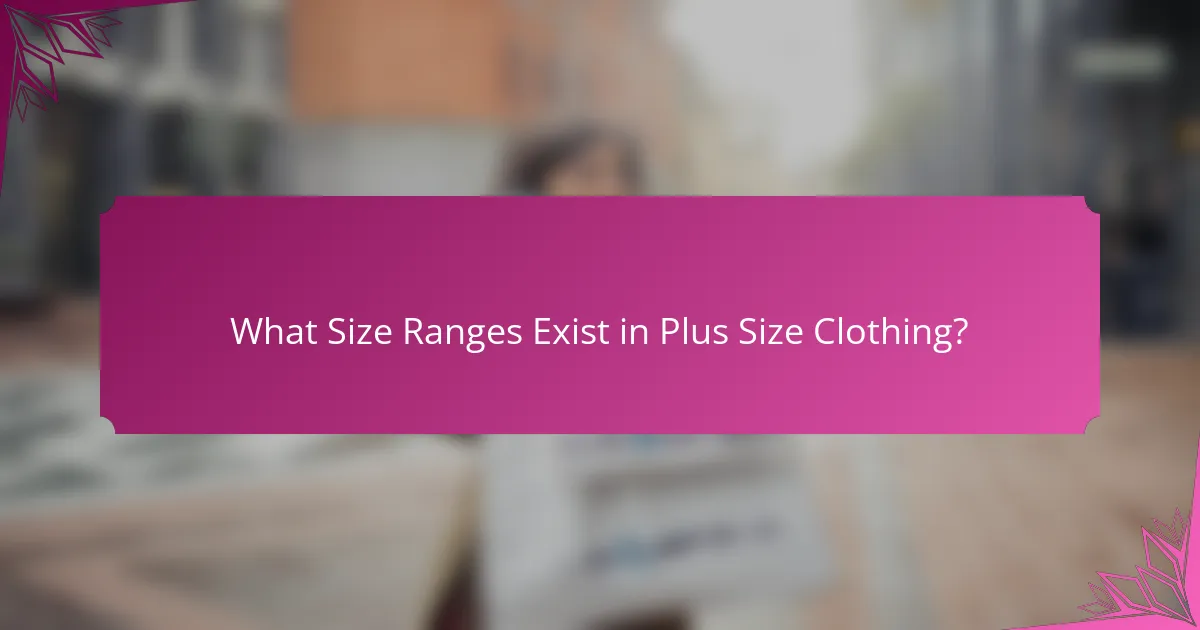
What Size Ranges Exist in Plus Size Clothing?
Plus size clothing typically ranges from size 14 to size 32 in women’s apparel. Some brands may start their plus size categories at size 12, while others may extend beyond size 32. The most common size classifications include 1X (14-16), 2X (18-20), and 3X (22-24). Additionally, sizes can vary significantly between different retailers. This inconsistency is due to differing size charts and fit standards. The fashion industry is increasingly recognizing the need for more inclusive sizing. Many brands now offer extended size ranges to accommodate diverse body types.
How do size ranges vary between brands?
Size ranges vary significantly between brands. Each brand may define its sizing based on different measurements and fit standards. For instance, one brand may categorize sizes from 14 to 28, while another may offer sizes from 12 to 20. This inconsistency can lead to confusion for consumers.
Moreover, brands often use unique size charts that do not align with industry standards. As a result, a size labeled as “16” in one brand may fit differently than a “16” from another.
Research indicates that 60% of women report inconsistencies in sizing across brands. This can affect purchasing decisions and overall satisfaction with fit. Therefore, understanding these variations is crucial for shoppers seeking plus size clothing.
What are common size labels used in plus size clothing?
Common size labels used in plus size clothing include 14W, 16W, 18W, and 20W. These sizes typically correspond to women’s sizes and are designed to accommodate fuller figures. Additionally, some brands use numerical sizes like 1X, 2X, and 3X. These labels are often associated with specific measurements, such as bust, waist, and hip sizes. For instance, a 1X usually fits a bust measurement of 43-45 inches. Understanding these labels helps consumers find the right fit in plus size clothing.
How can one navigate inconsistent sizing across different retailers?
To navigate inconsistent sizing across different retailers, one should always refer to size charts. Each retailer may have unique sizing standards. Measuring your own body can provide accurate dimensions. Compare your measurements with the retailer’s size chart before purchasing. Reading customer reviews can also provide insights on fit. Some brands may run larger or smaller than others. When possible, try items on in-store. This allows for a better understanding of fit and comfort.
What role do size charts play in selecting Plus Size Clothing?
Size charts are essential tools for selecting plus size clothing. They provide accurate measurements that help consumers find the right fit. Plus size clothing often varies between brands, making size charts crucial for consistency. These charts typically include bust, waist, and hip measurements. Knowing these dimensions aids in avoiding size-related frustrations. Research indicates that proper fit enhances comfort and confidence in wearers. Size charts also assist in online shopping, where trying on is not possible. Therefore, they play a vital role in ensuring satisfaction with clothing purchases.
How can size charts help in finding the right fit?
Size charts help in finding the right fit by providing standardized measurements for clothing sizes. These charts typically include bust, waist, hip, and inseam measurements. By comparing personal measurements to the size chart, individuals can identify their corresponding size. This reduces the likelihood of purchasing ill-fitting garments. Many brands have different sizing standards, making size charts essential for accurate fitting. Research shows that using size charts can decrease return rates by up to 30%. Therefore, size charts are crucial tools for ensuring a proper fit in plus size clothing.
What should one look for in a size chart for plus size clothing?
One should look for accurate measurements in a size chart for plus size clothing. Key dimensions include bust, waist, and hip measurements. Additionally, the chart should specify the garment’s length and sleeve length. It is essential that the size chart aligns with the specific brand’s sizing, as sizes can vary significantly. Look for a size chart that includes both numerical sizes and corresponding measurements. A good size chart may also indicate the fit type, such as relaxed or fitted. Finally, check for any notes on stretch or fabric type, as these can affect fit. Accurate size charts help ensure a better fit and reduce the need for returns.
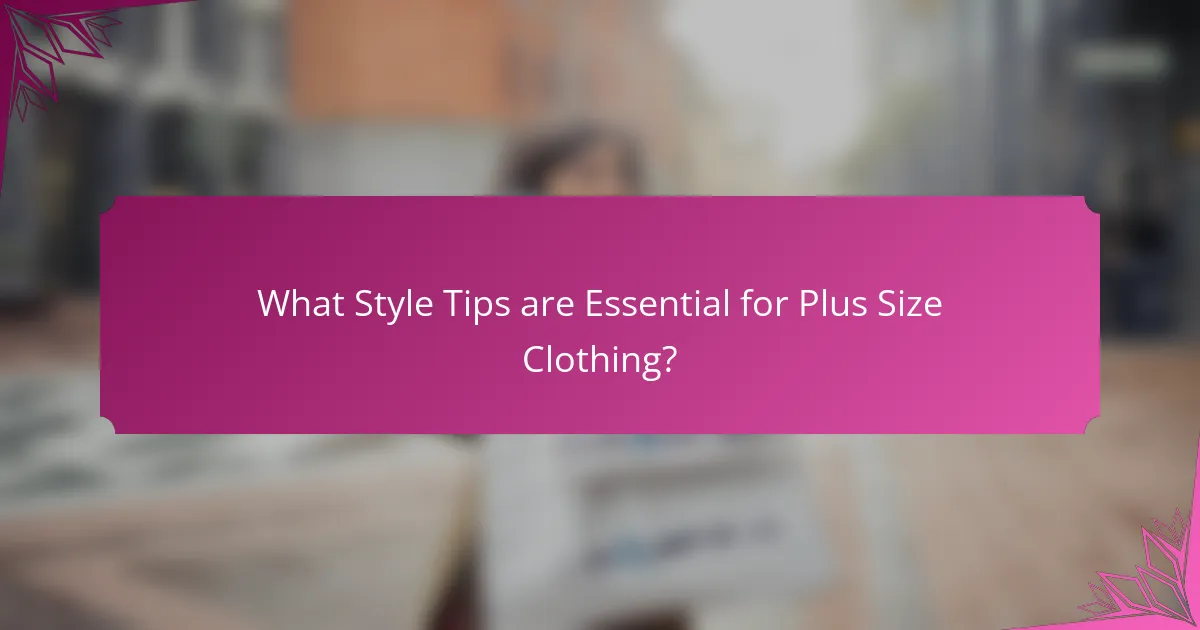
What Style Tips are Essential for Plus Size Clothing?
Choose well-fitted clothing that flatters your body shape. Tailored garments enhance your silhouette. Opt for darker colors to create a slimming effect. Patterns can also work; choose vertical stripes for elongation. Use layers to add dimension without bulk. Accessories can draw attention to your best features. High-waisted styles can define your waistline. Invest in quality fabrics that drape well, avoiding clingy materials.
How can one dress to flatter a plus size figure?
To flatter a plus size figure, choose clothing that accentuates curves and provides structure. Opt for A-line dresses that cinch at the waist. This creates an hourglass silhouette. High-waisted pants can elongate the legs and define the waist. Dark colors are slimming and can be paired with brighter accessories. Vertical stripes can create the illusion of height. Fabrics that drape well, like jersey or chiffon, can enhance comfort and style. Tailored pieces can improve fit and overall appearance. Avoid overly baggy clothing, as it can add bulk.
What are some key styling tricks for enhancing body shape?
Key styling tricks for enhancing body shape include using tailored clothing, strategic layering, and selecting the right fabrics. Tailored clothing helps define the silhouette and creates a polished look. Layering can add dimension and shape, especially with structured pieces like blazers. Choosing fabrics with a slight stretch can enhance comfort while maintaining shape. High-waisted bottoms can elongate the legs and define the waist. A-line dresses and skirts flatter various body shapes by skimming over curves. Vertical stripes can create an illusion of height and slimness. Lastly, accessories like belts can cinch the waist and emphasize curves. These techniques are widely recommended by fashion experts for achieving a balanced body shape.
How can layering be effectively used in plus size outfits?
Layering can effectively enhance plus size outfits by creating a balanced silhouette. It allows for the combination of various textures and lengths. For instance, pairing a longer cardigan with a fitted top can elongate the body. Additionally, using lightweight fabrics prevents bulkiness. Incorporating vests or structured jackets can add definition to the waist. Layering also provides versatility for different occasions. It enables easy transitions between seasons by adding or removing pieces. According to fashion experts, strategic layering can boost confidence and style in plus size fashion.
What are the common misconceptions about Plus Size Clothing?
Common misconceptions about plus size clothing include the belief that it lacks style and variety. Many assume that plus size options are limited to basic or unflattering designs. However, numerous brands now offer trendy and fashionable choices for plus size consumers. Another misconception is that plus size clothing is always more expensive. While some brands may charge higher prices, many affordable options exist. Additionally, people often think that plus size clothing is only for overweight individuals. In reality, plus size encompasses a wide range of body types and sizes. Many also believe that plus size clothing is not available in high-quality materials. In fact, many plus size lines use premium fabrics that provide comfort and durability.
How can understanding these misconceptions help in better fashion choices?
Understanding misconceptions about plus size clothing can lead to better fashion choices. Many people believe that plus size clothing is unflattering or limited in style. This misconception can prevent individuals from exploring diverse fashion options available in larger sizes. Recognizing that plus size clothing can be stylish and well-fitting encourages consumers to try new trends. Studies show that positive body image correlates with increased confidence in fashion choices. When individuals understand that fit and style are not exclusive to smaller sizes, they are more likely to invest in quality pieces. This shift in perspective can enhance personal style and satisfaction with clothing.
What positive changes are being made in the fashion industry for plus size individuals?
The fashion industry is increasingly embracing plus size individuals through various positive changes. Many brands are expanding their size ranges to include more plus size options. This shift is evident as major retailers now offer sizes up to 5X or larger. Additionally, there is a growing emphasis on trendy and stylish designs specifically for plus size consumers. Collaborations with plus size influencers have also gained traction, promoting body positivity and representation. Research shows that 67% of women in the U.S. wear a size 14 or above, highlighting the demand for inclusive fashion. Furthermore, fashion shows are now featuring plus size models, enhancing visibility in the industry. These changes reflect a significant cultural shift towards inclusivity and acceptance in fashion.
What practical tips can help in finding the perfect plus size outfit?
To find the perfect plus size outfit, focus on fit, comfort, and style. Start by knowing your measurements. Accurate measurements help in selecting the right size. Look for brands that specialize in plus size clothing. These brands often understand the unique fit challenges. Choose clothing with stretch fabrics. Stretch materials provide comfort and flexibility. Consider layering to create flattering silhouettes. Layering can enhance your overall look. Pay attention to the cut of the clothing. A-line dresses and high-waisted pants are often more flattering. Don’t shy away from bold colors and patterns. They can express your style and boost confidence. Finally, try on multiple styles. Different cuts can dramatically change how an outfit looks on you.
How can one effectively shop for plus size clothing online?
To effectively shop for plus size clothing online, one should start by knowing their accurate measurements. This includes bust, waist, and hip measurements. Many retailers provide size charts to help translate measurements into sizes. Reading customer reviews is crucial as it offers insight into fit and quality. Look for retailers that offer free returns to facilitate easy exchanges. Familiarizing oneself with the brand’s sizing can prevent ordering the wrong size. Shopping during sales can provide cost-effective options. Finally, consider versatile pieces that can be styled in multiple ways. These strategies enhance the online shopping experience for plus size clothing.
What are some do’s and don’ts in styling plus size outfits?
Do’s in styling plus size outfits include choosing well-fitted clothing that enhances body shape. Opt for structured fabrics that provide support and avoid clingy materials. Incorporate layers to create dimension and balance the silhouette. Use darker colors for a slimming effect while adding pops of color through accessories. Embrace patterns that flatter your figure, such as vertical stripes or small prints. Don’ts include wearing oversized clothing that can overwhelm the body shape. Avoid high necklines that can shorten the torso. Steer clear of overly tight garments that can create unflattering bulges. Do not shy away from bold styles; instead, choose pieces that express your personality.
Plus size clothing refers to garments designed for individuals typically above a size 14 in women’s fashion, addressing the specific fit, style needs, and body confidence of larger body types. This article examines the definition of plus size clothing in the fashion industry, common fit challenges, size ranges across different brands, and essential style tips for enhancing body shape. It highlights the importance of understanding fabric and construction, navigating inconsistent sizing, and the positive changes in the fashion industry towards inclusivity for plus size individuals. Key insights include common misconceptions, practical shopping tips, and styling do’s and don’ts for creating flattering outfits.
